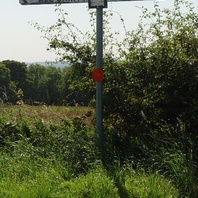
Viking Names
Saxby All Saints
Saxby All Saints, in the Yarborough Wapentake of Lincolnshire, probably takes its name from the Old Norse and Old Danish male personal name Saksi and the Old Norse element by ‘farmstead, village’. This personal name is very common throughout Lincolnshire and Norfolk. Alternatively, the first element of the place-name could be a Scandinavian gen. pl. form of an ethnonym: Old English S(e)axe, Old Norse Saksar ‘Saxons’. Thus the place-name would mean ‘Saxons’ farm/settlement’. The exact implications of such a name are not yet fully understood and are the subject of ongoing work by Dr Jayne Carroll of the Institute for Name-Studies, University of Nottingham. All Saints was affixed at a later date from the dedication of the church.
Read More
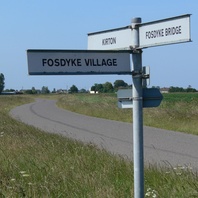
Viking Names
Fosdyke
Fosdyke, in the Kirton Wapentake of Lincolnshire, comes from the Old Norse male personal name Fótr and Old Norse element dík ‘a ditch, a water-channel’. The same personal name occurs in other place-names in Lincolnshire: Foston and Fotherby as well as possibly in Foston, Derbyshire.
Read More
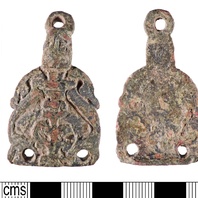
Viking Objects
Stirrup-Strap Mount (LIN-D274D5)
This Anglo-Scandinavian cast copper-alloy stirrup-strap mount is decorated with zoomorphic ornamentation. It has been classified as a William Class A Type 6 mount.
Read More
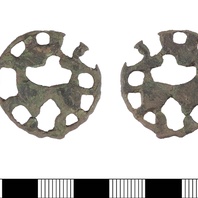
Viking Objects
Urnes-Style Mount (LIN-FA6943)
This copper-alloy mount features Urnes-style openwork decoration.
Read More

Viking Names
Southorpe
Southorpe, in the Corringham Wapentake of Lincolnshire, is recorded in Domesday Book as a simplex name from Old Norse þorp ‘a secondary settlement, a dependent outlying farmstead or hamlet’. The prefix was added later to distinguish it from Northorpe.
Read More
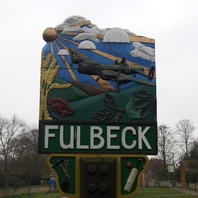
Viking Names
Fulbeck
Fulbeck, in the Loveden Wapentake of Lincolnshire, is an Anglo-Scandinavian hybrid formed from Old English fūl ‘foul, dirty’ and Old Norse bekkr ‘stream, a beck’, which likely replaced Old English broc, ‘brook’ based on earlier forms of the place-name.
Read More

Viking Names
Klypp
Klyppr was originally a byname and probably a mutated form related to klumpr ‘clump’. A number of instances are recorded in West Scandinavia from the eleventh century onwards. Klyppr is the first element in the place-names of Clipstone, Nottinghamshire and Clixby, Lincolnshire.
Read More
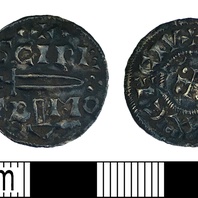
Viking Objects
Silver Viking Penny (DENO-FCA770)
This is a silver penny of a type know as the St Peter Sword/Cross type which bears an inscription to St Peter of York (c. 905-927) and was minted at York between 921 and 927. Viking rulers in the Danelaw eventually took up the Anglo-Saxon practice of minting coins which helped legitimise their authority.
Read More
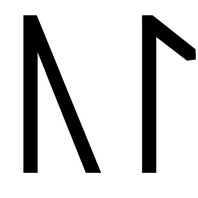
Viking Names
Gulla
Gulla is recorded in several runic inscriptions in Sweden. There is one attestation of Gulla in the form of Golle in a medieval Lincolnshire document (c. 1218-1219). It is a short form of Old Norse names in Guðl-.
Read More
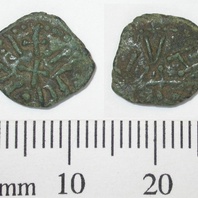
Viking Objects
Northumbrian Styca (DENO-EF4544)
The blundered legends on this example suggest it is an imitation of stycas minted for a Northumbrian ruler or the Archbishops of York. While Wessex and Mercia were using silver coinage as part of their monetary economy, Northumbria was using copper coins known as stycas, which may have contained trace amounts of silver. The concentration of these coins at sites such as Torksey and ARSNY suggests that they could have remained in circulation after the fall of Northumbria in 866 but were taken to the sites by the Vikings during their campaigning. They were not much use to the Vikings within their silver-based bullion economy but it is suggested that they were treated as raw material and were used as commodity money instead. The evidence for the production of copper-alloy strap-ends at Torksey and ARSNY supports this idea that the stycas were used for production.
Read More
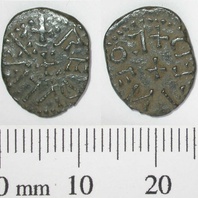
Viking Objects
Northumbrian Styca (DENO-60AFD2)
This copper-alloy styca was probably minted by the moneyer Coenred in the name of King Redwulf of Northumbria. While Wessex and Mercia were using silver coinage as part of their monetary economy, Northumbria was using copper coins known as stycas, which may have contained trace amounts of silver. The concentration of these coins at sites such as Torksey and ARSNY suggests that they could have remained in circulation after the fall of Northumbria in 866 but were taken to the sites by the Vikings during their campaigning. They were not much use to the Vikings within their silver-based bullion economy but it is suggested that they were treated as raw material and were used as commodity money instead. The evidence for the production of copper alloy strap-ends at Torksey and ARSNY supports this idea that the stycas were used for production.
